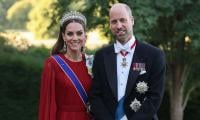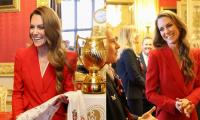From inside the MQM headquarters
KARACHI: The moment we entered Azizabad, a thickly populated part of Central Karachi, I saw the portraits of Altaf Hussain hanging on almost every pole in the streets. The roads were cleaner then in other parts of the city. I asked if mobile snatchers are also active here, “No, not
By Azaz Syed
March 07, 2015
KARACHI: The moment we entered Azizabad, a thickly populated part of Central Karachi, I saw the portraits of Altaf Hussain hanging on almost every pole in the streets. The roads were cleaner then in other parts of the city. I asked if mobile snatchers are also active here, “No, not at all, they would die if they did “, my driver abruptly answered.
I was anxiously curious to know the working of the Muttahida Qaumi Movement (MQM), which has dominated the country’s largest city and its economic hub for almost more then two decades.
Allegations of torture, killings and extortions also appear against the party but MQM is not only intact and organised but also is playing its role at the national level through Parliament. Despite in self-exile in London since 1992, Altaf Hussain controls the party apparently without any challenge. MQM is one of the most vocal opponents of Talbanization of the country.
Taking a turn from a roundabout I saw a big iron-made ‘fist’ in the center of the two roads called “Muka Chowk” (fist roundabout), my driver, a local Karachiite told me. “This is the symbol of unity with the Altaf Bhai,” he driver. For rest of Pakistan MQM chief is known as Altaf Hussain but for Karachiites he is Altaf Bhai who founded his party in late 80’s initially on ethnic grounds - Mohajir Qaumi Movement - but later he attempted to give it a national look by replacing the word ‘Mohajir’ with ‘Muttahidda’.
The moment we tried to enter in the area from Muka Chowk towards Nine Zero, three plainclothes men carrying wireless sets stopped us and inquired about our identities. After recognising me they let our car inside the area. Are they from Rangers? I asked the driver. No this is the area of MQM and they are party workers. I did not see any weapon in their hands though pickets were installed there.
Next came the Jinnah Ground where MQM holds public meetings. Here I confronted another picket manned by MQM workers who directed me towards the Khurshid Memorial Hall. I had left my driver there, as only the vehicles of the local residents and the cars approved by the MQM officials could enter the area. It was about 10:00 pm.
Passing through another security picket I reached in front of a four-storey building located on 20-feet street next to an under-construction seven-storey building.
This is Khurshid Memorial Hall, the MQM secretariat from where its Rabta Committee nominated by MQM Chief Altaf Hussain operates. Nine-zero is a small five marla house of Altaf Hussain. Actually the party operates from Khurshid Memorial Hall, named after the late mother of the MQM chief.
The building has three entry points; the front gate is used for exit only whereas the right side gate is used is entrance where a digital walk through gate is installed. The left side gate remains closed.
As you enter the building you pass through the tiled lawn where palm trees give a different look. The moment I saw the hall I thought it resembled the old building of a spy agency in Aabpara, Islamabad.
The building was alive at 10:15 pm. I saw people sitting inside the building doing their routine work. At the entrance of the building I saw an 8 feet board of a kite, the election symbol of the MQM placed there. The moment you enter the building, on the left side you see a small room with desks, you pass through it and reach the reception where you are asked, “who are you here to see?” I told them about my host, Haider Abbas Rizvi, an MQM leader who in Parliament used to tell his Punjabi friends about his leader and his party.
I introduced myself to the receptionist who asked me to wait on one of the benches fixed outside in the lawn. My host was downstairs looking for me.
Haider Abbas being a nice host wanted to take me for famous Nehari but on my request he took me around the Khurshid Memorial Hall. We started from the ground floor. The first left side small room was shown to me where each leader of the MQM on rotation basis sits to listen to the complaints of the people. The walls of the ground floor are filled with pictures of Altaf Hussain.
Then I was taken to the main room of the Rabita Committee on the first floor where their party chief speaks with the leaders and gives them directions. This is almost similar to a war room.
In the center there is a wooden table on which three speakerphones are placed besides two digital dial phones, papers and pens. Six chairs are arranged around the table. Almost two feet away from the table leather sofas are placed on the front and right sides of the room. Six LCDs were placed on the wall showing different news channels, a wooden cupboard stands in the corner of the room. The front left side of the room connects the main room to another small room through a tiny dinning room where I saw Wasay Jalil sitting in a chair.
Then I toured the Punjab, Sindh, KPK, Balochistan, Gilgit Baltistan and Sindh sections located in different rooms. In each section five to 15 people sit till midnight. All sections have files in the steel cupboards installed there. The Sindh section and Karachi section were visibly most active sections where I found most men sitting. I was told that the MQM secretariat works round the clock, each call to any of its section is noted and the duty leaders are bound to respond to it.
I was also taken to a special room where MQM workers prepare the lists of their arrested and missing workers. I was also taken to the canteen where I was told that each man working in the secretariat comes and collects the food of his choice.
I was also taken to the communication and research centers of the party, where I found party workers working late into the night. I was told that these sections provide research findings to the party on each issue including suggestions, advice and written text. I was deeply impressed by the dedication of MQM workers.
I wondered who paid for all this and asked my host about the allegations of extortion (bhahtta khori). He laughed and showed me some small slips saying our opponents call it extortion whereas it is 1 per cent of the income of the each MQM worker, which he is bound to submit to the party. He showed me the boards where collections from workers were noted regularly.
On our way out of the building, a young lady along with her brother stopped Haider Abbas and gave him an application probably seeking monitory help. Haider approved it and the lady went inside the building.
Boarding in the jeep I realised that it was a bulletproof vehicle. Haider told me that it was given to him by his party. In the secretariat I was told that the party has more then 43 subsidiary organisations but I was curious about the intelligence wing, and put the question to my host, to which he showed ignorance. I told him that a couple of years back MQM had issued a press release referring to its intelligence wing of which Haider was unaware.
I was told that each central party leader in his residential area does come under the Sector and Unit Commander of the party whom he is bound to obey. If the party suspends any of its leader or worker he faces social boycott.
“This is our discipline, and the only option for the suspended party worker is to request for review,” said Haider Abbas Rizvi defending the party policy. It seems as if MQM is not a party but a religion, I shared my observation with my host. Arif Shah sitting next to Haider Abbas interrupted and said, “We have a party whom we follow religiously”. I was told that for each situation the party has made standard operating procedures with chain of command for each sector.
While having delicious Nehari at Javed Nehari I was thinking how come the most organised political party of this country could not have plan “B”, in case something happens to its self-exiled leader Altaf Hussain.
I was anxiously curious to know the working of the Muttahida Qaumi Movement (MQM), which has dominated the country’s largest city and its economic hub for almost more then two decades.
Allegations of torture, killings and extortions also appear against the party but MQM is not only intact and organised but also is playing its role at the national level through Parliament. Despite in self-exile in London since 1992, Altaf Hussain controls the party apparently without any challenge. MQM is one of the most vocal opponents of Talbanization of the country.
Taking a turn from a roundabout I saw a big iron-made ‘fist’ in the center of the two roads called “Muka Chowk” (fist roundabout), my driver, a local Karachiite told me. “This is the symbol of unity with the Altaf Bhai,” he driver. For rest of Pakistan MQM chief is known as Altaf Hussain but for Karachiites he is Altaf Bhai who founded his party in late 80’s initially on ethnic grounds - Mohajir Qaumi Movement - but later he attempted to give it a national look by replacing the word ‘Mohajir’ with ‘Muttahidda’.
The moment we tried to enter in the area from Muka Chowk towards Nine Zero, three plainclothes men carrying wireless sets stopped us and inquired about our identities. After recognising me they let our car inside the area. Are they from Rangers? I asked the driver. No this is the area of MQM and they are party workers. I did not see any weapon in their hands though pickets were installed there.
Next came the Jinnah Ground where MQM holds public meetings. Here I confronted another picket manned by MQM workers who directed me towards the Khurshid Memorial Hall. I had left my driver there, as only the vehicles of the local residents and the cars approved by the MQM officials could enter the area. It was about 10:00 pm.
Passing through another security picket I reached in front of a four-storey building located on 20-feet street next to an under-construction seven-storey building.
This is Khurshid Memorial Hall, the MQM secretariat from where its Rabta Committee nominated by MQM Chief Altaf Hussain operates. Nine-zero is a small five marla house of Altaf Hussain. Actually the party operates from Khurshid Memorial Hall, named after the late mother of the MQM chief.
The building has three entry points; the front gate is used for exit only whereas the right side gate is used is entrance where a digital walk through gate is installed. The left side gate remains closed.
As you enter the building you pass through the tiled lawn where palm trees give a different look. The moment I saw the hall I thought it resembled the old building of a spy agency in Aabpara, Islamabad.
The building was alive at 10:15 pm. I saw people sitting inside the building doing their routine work. At the entrance of the building I saw an 8 feet board of a kite, the election symbol of the MQM placed there. The moment you enter the building, on the left side you see a small room with desks, you pass through it and reach the reception where you are asked, “who are you here to see?” I told them about my host, Haider Abbas Rizvi, an MQM leader who in Parliament used to tell his Punjabi friends about his leader and his party.
I introduced myself to the receptionist who asked me to wait on one of the benches fixed outside in the lawn. My host was downstairs looking for me.
Haider Abbas being a nice host wanted to take me for famous Nehari but on my request he took me around the Khurshid Memorial Hall. We started from the ground floor. The first left side small room was shown to me where each leader of the MQM on rotation basis sits to listen to the complaints of the people. The walls of the ground floor are filled with pictures of Altaf Hussain.
Then I was taken to the main room of the Rabita Committee on the first floor where their party chief speaks with the leaders and gives them directions. This is almost similar to a war room.
In the center there is a wooden table on which three speakerphones are placed besides two digital dial phones, papers and pens. Six chairs are arranged around the table. Almost two feet away from the table leather sofas are placed on the front and right sides of the room. Six LCDs were placed on the wall showing different news channels, a wooden cupboard stands in the corner of the room. The front left side of the room connects the main room to another small room through a tiny dinning room where I saw Wasay Jalil sitting in a chair.
Then I toured the Punjab, Sindh, KPK, Balochistan, Gilgit Baltistan and Sindh sections located in different rooms. In each section five to 15 people sit till midnight. All sections have files in the steel cupboards installed there. The Sindh section and Karachi section were visibly most active sections where I found most men sitting. I was told that the MQM secretariat works round the clock, each call to any of its section is noted and the duty leaders are bound to respond to it.
I was also taken to a special room where MQM workers prepare the lists of their arrested and missing workers. I was also taken to the canteen where I was told that each man working in the secretariat comes and collects the food of his choice.
I was also taken to the communication and research centers of the party, where I found party workers working late into the night. I was told that these sections provide research findings to the party on each issue including suggestions, advice and written text. I was deeply impressed by the dedication of MQM workers.
I wondered who paid for all this and asked my host about the allegations of extortion (bhahtta khori). He laughed and showed me some small slips saying our opponents call it extortion whereas it is 1 per cent of the income of the each MQM worker, which he is bound to submit to the party. He showed me the boards where collections from workers were noted regularly.
On our way out of the building, a young lady along with her brother stopped Haider Abbas and gave him an application probably seeking monitory help. Haider approved it and the lady went inside the building.
Boarding in the jeep I realised that it was a bulletproof vehicle. Haider told me that it was given to him by his party. In the secretariat I was told that the party has more then 43 subsidiary organisations but I was curious about the intelligence wing, and put the question to my host, to which he showed ignorance. I told him that a couple of years back MQM had issued a press release referring to its intelligence wing of which Haider was unaware.
I was told that each central party leader in his residential area does come under the Sector and Unit Commander of the party whom he is bound to obey. If the party suspends any of its leader or worker he faces social boycott.
“This is our discipline, and the only option for the suspended party worker is to request for review,” said Haider Abbas Rizvi defending the party policy. It seems as if MQM is not a party but a religion, I shared my observation with my host. Arif Shah sitting next to Haider Abbas interrupted and said, “We have a party whom we follow religiously”. I was told that for each situation the party has made standard operating procedures with chain of command for each sector.
While having delicious Nehari at Javed Nehari I was thinking how come the most organised political party of this country could not have plan “B”, in case something happens to its self-exiled leader Altaf Hussain.
-
 Kelly Clarkson Discovers A Shark Named In Her Honour
Kelly Clarkson Discovers A Shark Named In Her Honour -
 HBO Mulls Major 'Game Of Thrones' Spin-off Focusing On A Stark
HBO Mulls Major 'Game Of Thrones' Spin-off Focusing On A Stark -
 Ashton Kutcher Says He's Proud Of Demi Moore
Ashton Kutcher Says He's Proud Of Demi Moore -
 Why Prince William, Kate Hired A Crisis Expert Despite Royal 'calm'?
Why Prince William, Kate Hired A Crisis Expert Despite Royal 'calm'? -
 Extent Of Meghan Markle’s Fears Gets The Spotlight: ‘The Press Detest Her Which Is A Problem’
Extent Of Meghan Markle’s Fears Gets The Spotlight: ‘The Press Detest Her Which Is A Problem’ -
 Caitlyn Jenner Finally Reacts To Kylie, Timothee Chalamet Relationship
Caitlyn Jenner Finally Reacts To Kylie, Timothee Chalamet Relationship -
 Prince William’s Beefed Up PR All Set To Fight Off ‘plot’ And ‘it Might Not Be Long’
Prince William’s Beefed Up PR All Set To Fight Off ‘plot’ And ‘it Might Not Be Long’ -
 Kate Middleton Ups A New Role Unofficially For King Charles As William Prepares His Coronation
Kate Middleton Ups A New Role Unofficially For King Charles As William Prepares His Coronation -
 Teyana Taylor Says She Misread Leonardo DiCaprio Globes Moment
Teyana Taylor Says She Misread Leonardo DiCaprio Globes Moment -
 A$AP Rocky Reveals What Encouraged Him To Date Rihanna
A$AP Rocky Reveals What Encouraged Him To Date Rihanna -
 Newborns At Risk: Health Experts Warn Your Baby Could Already Have Diabetes
Newborns At Risk: Health Experts Warn Your Baby Could Already Have Diabetes -
 Sarah Ferguson Updates Her Plans Now That Andrew’s Eviction Is Nine Days Away
Sarah Ferguson Updates Her Plans Now That Andrew’s Eviction Is Nine Days Away -
 Hailey Bieber Sends Cease And Desist To TikToker
Hailey Bieber Sends Cease And Desist To TikToker -
 Kate Middleton Celebrates England Women's Rugby Stars After World Cup Win
Kate Middleton Celebrates England Women's Rugby Stars After World Cup Win -
 Kris Jenner Dubs Chicago West Her 'sweet Angel' As She Turns Eight
Kris Jenner Dubs Chicago West Her 'sweet Angel' As She Turns Eight -
 Josh Charles Credits Taylor Swift For His, Ethan Hawke’s Moon Person Trophies
Josh Charles Credits Taylor Swift For His, Ethan Hawke’s Moon Person Trophies



